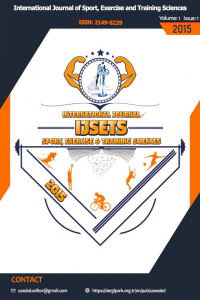Talent classification of motoric parameters with support vector machine
Talent classification of motoric parameters with support vector machine
Talent selection, classification, support vector machines,
___
- Akgün, N. (1994) Egzersiz Fizyolojisi. İzmir: Ege Üniversitesi Basımevi.
- Aydos, L. (1991) Fiziksel Uygunluk, Gazi Eğitim Fakültesi Dergisi, 69-79.
- Bunker, R.P. & Fadi, T. (2017) A machine learning framework for sports result prediction, Applied Computing and Informatics, https://doi.org/10.1016/j.aci.2017.09.005
- Buekers, M., Borry, P., Rowe, P. (2015) Talent in sports. some reflections about the search for future champions. Movement & Sport Sciences – Science & Motricit´e; 88, 3–12
- Cavedon, V., Zancanaro, C., Milanese, C. (2015) Physique and Performance of Young Wheelchair Basketball Players in Relation with Classification. PLoS ONE 10(11): e0143621. https://doi.org/10.1371/journal.pone.0143621
- Cicioğlu, H., Kürkçü, R., Eroğlu, H., & Yüksel, S. (2007) 15-17 Yaş güreşçilerin fiziksel ve fizyolojik özelliklerinin sezonsal değişimi: Spormetre Beden Eğitimi ve Spor Bilimleri Dergisi 5: 1 51-6.
- Clarke, O.H. (1975) Exercise Physiology, Prentice Hall. New Jersey, USA.
- Coşan, F., Demir, A., Mengütay, S. (Ed). (2002) Türk Çocuklarının Fiziki Uygunluk Normları. İstanbul Olimpiyat Oyunları Hazırlık ve Düzenleme Kurulu Eğitim Yayınları Yayın No 1., İstanbul.
- Çalışkan, O. (2013) Özel düzenlenmiş Plyometrik antrenmanların atletizm yapan 11-13 yaş çocukların aerobik ve anaerobik güçlerine etkisi. Yüksek Lisans Tezi, Aksaray Üniversitesi Sosyal Bilimler Enstitüsü. Aksaray.
- Davoodi, E. & Khanteymoori, A. (2010) Horse racing prediction using artificial neural networks, Recent Adv. Neural Networks, Fuzzy Syst. Evol. Comput., pp. 155-160
- Figueiredo, A.J., Gonçalves, C.E., Coelho, E., et al. (2009): Youth soccer players, 11-14 years: Maturity, size, function, skill and goal orientation. Annals of Human Biology (36), 60-73.
- Gündüz, N. (2005) Antrenman Bilgisi, Birinci baskı, İzmir, Saray Medical Yayıncılık, sf. 21 22.
- Gündüz, N. (1997) Antrenman Bilgisi. Saray medikal yayıncılık 2. Yayın İzmir; s.23
- Kamar, A. (2003) Sporda Yetenek Beceri ve Performans Testleri. Nobel Yayın Dağıtım. Ankara; s.40-41
- Karl, K. (2001) Sporda Yetenek Arama Seçme ve Yönlendirme Antrenör Eğitim Dizisi. Bağırgan Yayınevi., Ankara.
- Magill, A.R. (1989) Motor learning Concepts and Applications, Third Ed. Iowa, Wch, Publishers, 17-34 Manfred, B. (1979) Training, Technik, Taktik: Reinbek. International Congress on judo. 1979
- Mccabe, A., & Trevathan, J. (2008). Artificial Intelligence in Sports Prediction. 1194-1197. 10.1109/ITNG.2008.203.
- Mengütay. S., Demir, A., Coşan, F. (2002) Olimpiyatlar İçin Sporcu Kaynağı Projesi, Olimpiyat Hazırlık ve Düzenleme Kurulu Eğitim Yayınları. İstanbul No 2, 102.
- Mitchell, H., Willams, L., & Reter, B.R. (1999) Classification of sports medicine and science in sports and exercise. American college of sports. Medicine and the American College of Cardiology, 56-85.
- O'Connor, D., Larkin, P., Mark, W.A. (2016) Talent identification and selection in elite youth football: An Australian context. Eur J Sport Sci. Oct;16(7):837-44
- Omosegoard, B. (1996) Physical Training for Badminton. İnternational Badminton Federation (JJBF)Denmark.
- Öcal, D, (2007) Elit Güreşçilerin Somototip Özellikleri ile Anropometrik Oransal İlişkilerinin Stiller ve Sikletler Arası Karşılaştırılması. Yüksek Lisans Tezi, Gazi Üniversitesi Sağlık Bilimleri Enstitüsü ve Spor Anabillim Dalı, Ankara.
- Özer, K. (2006) Fiziksel Uygunluk. 2. Baskı, Nobel Yayın Dağıtım. İstanbul s. 11, 118-120, 160.
- Pehlivan, Z. (1997) 1995-1996 sezonunda Türkiye 1. Deplasmanlı Bayanlar Basketbol, Hentbol ve Voleybol Liglerinde Şampiyon olan sporcuların fiziksel ve fizyolojik özelliklerinin değerlendirilmesi; Gazi Üniversitesi Sağlık Bilimleri Enstitüsü Yüksek Lisans Tezi 1997.
- Razali, N., Mustapha, A., Yatim, A.F., Aziz, A.R. (2017) Predicting player position for talent identification in association football. International Research and Innovation Summit (IRIS2017). IOP Conf. series: materials science and engineering.; 226 012087
- Sharif, A.H., George, J., Ramlan, A.A. (2009) Musculoskeletal Injuries Among Malaysian Badminton Players. Singapore Med J. Nov; 50(11); 1095-7.
- Stolen, T., Chamari, K., Castagna, C., Wisloff, U. (2005). Physiology of soccer. Sports Medicine. 35(6):501–536.
- Tamer, K. (1991) Fiziksel Performansın Ölçülmesi ve Değerlendirilmesi. (Egzersiz Fizyolojisi Laboratuvar Rehberi) Gökçe offset matbaacılık Ankara. S.32
- Till, K., Ben, L., Jones, S., Cobley, D., Morley, J., O'Hara, C., Chapman, C., Cooke, and Clive B. Beggs, (2016) Identifying Talent in Youth Sport: A Novel Methodology Using Higher-Dimensional Analysis, PLoS One. 2016; 11(5): e0155047.
- Vaeyens, R., Lenoir, M., Williams, M.A., Philippaerts, M.P. (2008) Talent identification anddevelopment programmes in sport current models and future directions. Sports Med. 38 (9): 703-714
- Vaeyens, R., Malina, R.M., Janssens, M., Van Renterghem, B., Bourgois, J., Vrijens, J. et al. (2006) A multidisciplinary selection model for youth soccer. The Ghent Youth Soccer Project. British Journal of Sports Medicine (40), 928-934.
- Woods, T.C., Veale, J., Fransen, J., Robertson, S., Collier, N.F. (2018) Classification of playing position in elite junior Australian football using technical skill indicators, Journal of Sports Sciences, 36:1, 97-103.
- ISSN: 2149-8229
- Başlangıç: 2015
- Yayıncı: İbrahim ERDEMİR
Mevlüt YILDIZ, Ender ŞENEL, Süleyman CAN
Kısa süreli SCUBA dalışlarının solunum fonksiyonlarına etkisi
Bengüsu MİRASOĞLU, Şahin ÖZEN, Şamil AKTAŞ
Talent classification of motoric parameters with support vector machine
Hanife KANAT USTA, Naci USTA, Adil Deniz DURU, Hasan Birol ÇOTUK
